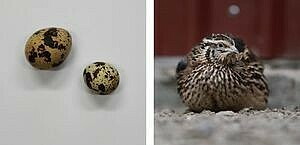Quail selection lines
The Japanese quail is a small galliform that naturally occurs in East Asia. Domestication of Japanese quail started centuries ago, and various types, mainly selected for egg or meat production, are now available throughout the world. Japanese quail are a popular avian model for the study of ageing, because (i) they reach sexual maturity in 6-8 weeks, (ii) reproductive activity can easily be manipulated by adjusting photoperiod, and (iii) birds have a short lifespan when reproductively active.
Because quail eggs can easily be artificially incubated and chicks reared without parents, the most variable aspect that determines parental investment in captive Japanese quail is the size of the egg. We recently acquired replicated lines of Japanese quail artificially selected for high and low investment in reproduction. These lines were established by Dr. Barbara Tschirren and selected for >5 generations for females that produced either small or large eggs relative to their own body size. The increased parental investment has been shown to improve offspring growth and survival (Pick et al. 2016 American Naturalist), but to reduce female lifespan (Tschirren et al. unpublished results). As such, these selection lines represent an ideal model for the study of trade-offs and different life-history strategies around the fast-slow axis within a species.
Our initial research plans are to use these lines to investigate under which circumstances late-life consequences of poor developmental conditions can evolve, and how such consequences are regulated.
| Projekt Wachtel |
| Dr. Oscar Vedder |
| Matteo Beccardi |
| Adolf Völk (Tierpflege) |


